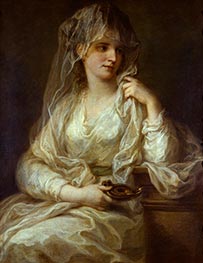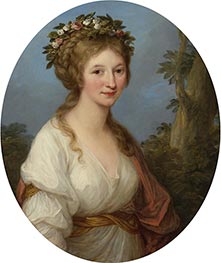
Angelica Kauffmann Giclée Fine Art Prints
1741-1807
Swiss Neoclassical Painter
Angelica Kauffman’s life is a story of remarkable talent, determination, and an extraordinary rise in a world that, for the most part, excluded women from serious artistic achievement. Born in Switzerland in 1741, Kauffman was nurtured from an early age by her father, Johann Joseph Kauffman, who recognized her gifts in both painting and music. Her education was broad and advanced for a woman of her time, and she grew up fluent in four languages. She had a fine singing voice and might have pursued a career in music, but ultimately it was painting that captured her devotion. This choice - between music and painting - would later become the subject of one of her most personal and famous works, "Self-Portrait Hesitating Between the Arts of Music and Painting."
From the start, Kauffman’s ambitions were extraordinary. In an era when women were rarely allowed to paint beyond portraiture or still life, she aspired to the heights of history painting - a genre considered the most prestigious and the most exclusively male. She trained rigorously in Italy, immersing herself in the works of the Old Masters, copying their paintings for wealthy Grand Tourists, and establishing important networks with patrons across Europe. By the time she arrived in London in 1766, she was already a seasoned artist with a growing reputation.
London, though, was where her career truly flourished. Kauffman’s charm, intelligence, and undeniable talent quickly attracted the attention of English high society, and soon her portraits were in high demand. She was one of the few women to gain entry into the elite art world - becoming one of the founding members of the Royal Academy in 1768, a singular achievement for a woman. Alongside Mary Moser, she would remain one of the only female Academicians for two centuries, a stark reminder of the barriers she had to overcome.
But Kauffman’s talents went beyond portraiture. Her neoclassical scenes, often drawn from mythological and literary sources, resonated with the emerging taste for sensibility in art. Her work explored themes of emotion, intellect, and feminine strength, finding beauty and depth in subjects like "Ariadne," "Calypso," and figures from Homer and Virgil. These paintings, often small in scale but rich in feeling, struck a chord with European audiences, and her fame spread through engravings that brought her work into the homes of a broader public.
By the time she returned to Italy in 1781 with her second husband, Venetian painter Antonio Zucchi, Kauffman was at the peak of her career. In Rome, she established a prestigious studio and continued to attract commissions from aristocrats and royalty, while her salon became a meeting place for the intellectual elite, including Goethe and Herder. She remained a highly influential figure, even as the tides of artistic fashion began to shift.
Angelica Kauffman died in 1807, leaving behind a legacy not only as an artist but as a symbol of what was possible for women in the arts. Her grand funeral in Rome, with her coffin carried by professors from the Academy, echoed the importance of her achievements. Kauffman had broken through the barriers of her time with a quiet but resolute determination, creating a body of work that still resonates with its grace, intellect, and emotional depth. She was, in every sense, a pioneer, and her life remains a powerful testament to the ability of women to succeed in even the most restrictive environments.
From the start, Kauffman’s ambitions were extraordinary. In an era when women were rarely allowed to paint beyond portraiture or still life, she aspired to the heights of history painting - a genre considered the most prestigious and the most exclusively male. She trained rigorously in Italy, immersing herself in the works of the Old Masters, copying their paintings for wealthy Grand Tourists, and establishing important networks with patrons across Europe. By the time she arrived in London in 1766, she was already a seasoned artist with a growing reputation.
London, though, was where her career truly flourished. Kauffman’s charm, intelligence, and undeniable talent quickly attracted the attention of English high society, and soon her portraits were in high demand. She was one of the few women to gain entry into the elite art world - becoming one of the founding members of the Royal Academy in 1768, a singular achievement for a woman. Alongside Mary Moser, she would remain one of the only female Academicians for two centuries, a stark reminder of the barriers she had to overcome.
But Kauffman’s talents went beyond portraiture. Her neoclassical scenes, often drawn from mythological and literary sources, resonated with the emerging taste for sensibility in art. Her work explored themes of emotion, intellect, and feminine strength, finding beauty and depth in subjects like "Ariadne," "Calypso," and figures from Homer and Virgil. These paintings, often small in scale but rich in feeling, struck a chord with European audiences, and her fame spread through engravings that brought her work into the homes of a broader public.
By the time she returned to Italy in 1781 with her second husband, Venetian painter Antonio Zucchi, Kauffman was at the peak of her career. In Rome, she established a prestigious studio and continued to attract commissions from aristocrats and royalty, while her salon became a meeting place for the intellectual elite, including Goethe and Herder. She remained a highly influential figure, even as the tides of artistic fashion began to shift.
Angelica Kauffman died in 1807, leaving behind a legacy not only as an artist but as a symbol of what was possible for women in the arts. Her grand funeral in Rome, with her coffin carried by professors from the Academy, echoed the importance of her achievements. Kauffman had broken through the barriers of her time with a quiet but resolute determination, creating a body of work that still resonates with its grace, intellect, and emotional depth. She was, in every sense, a pioneer, and her life remains a powerful testament to the ability of women to succeed in even the most restrictive environments.
2 Angelica Kauffmann Artworks

Giclée Canvas Print
$72.67
$72.67
SKU: 18854-KAA
Angelica Kauffmann
Original Size:91.5 x 71.5 cm
Gemaldegalerie Alte Meister, Dresden, Germany
Angelica Kauffmann
Original Size:91.5 x 71.5 cm
Gemaldegalerie Alte Meister, Dresden, Germany

Giclée Canvas Print
$79.17
$79.17
SKU: 18007-KAA
Angelica Kauffmann
Original Size:76.8 x 63.5 cm
Private Collection
Angelica Kauffmann
Original Size:76.8 x 63.5 cm
Private Collection